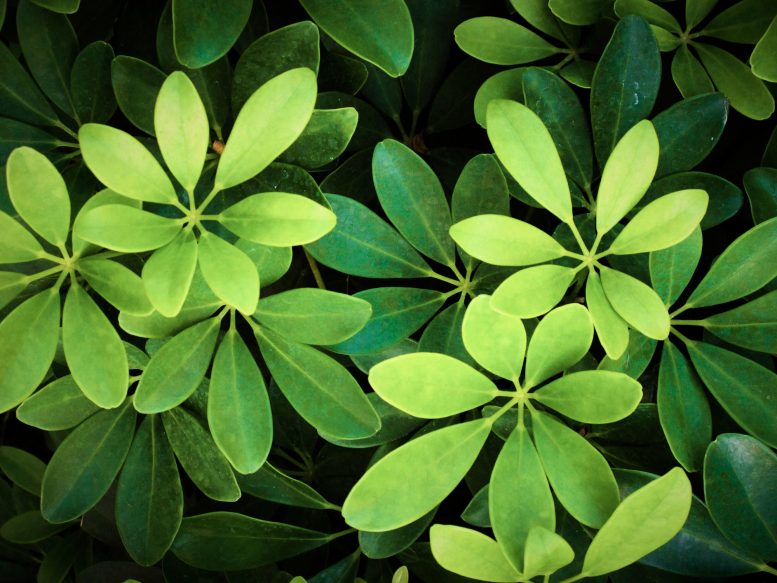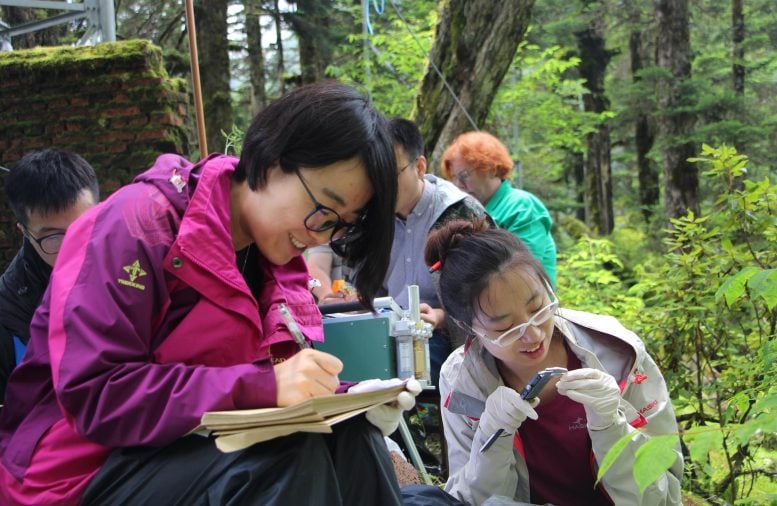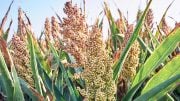
The researchers expect the new findings to improve global and regional climate models, aid in forest and vegetation management, and provide more accurate predictions on crop yield and climate change’s impact on agriculture.
How long will a leaf live? It’s an economic decision.
The leaves of Monkey Puzzle trees have a lifespan of more than 20 years, while Picea trees growing in the Gongga Mountains in China can survive for millennia. Despite growing in harsh conditions, these trees grow slowly, and their leaves typically last an average of 20 years.
In contrast, maple leaves survive for only one season, while blueberry leaves have a lifespan of a mere three months.
So, what determines the lifespan of a tree leaf?
The answer to that superficially simple question is reported today in a paper in Science Advances by an international team of researchers from China, the UK, Japan, Norway, USA, and Australia.

Dr. Han Wang and colleagues. Credit: Dr. Han Wang
“It’s all about the economic choices faced by plants,” says first author, Dr. Han Wang from Tsinghua University in Beijing.
“We already knew that conifers and other evergreen trees make longer-living leaves the closer they are to the poles,” she says. “Deciduous trees do the opposite. Their longest-lasting leaves are found in the tropics.”
“And we knew that long-lived leaves tend to be tougher and thicker, and more expensive to build.”
“Now, we have identified the major environmental factors at play, and summarised them in two equations,” she says. “These leaf economic traits are fundamental to the carbon cycle and nutrient economy.”

Relationship between leaf life (LL) and leaf mass per unit area in (1) evergreens and (2) deciduous plants. Credit: Dr. Han Wang et al
The team tested their equations using data from thousands of species from hundreds of ecosystems, drawn from the China Plant Trait Database and the Global Plant Trait Network.
“Each species is essentially taking a punt on the best way to maximize carbon absorption,” says co-author Professor Ian Wright from Macquarie University and Western Sydney University.

Professor Ian Wright. Credit: Ian Wright
“Evergreen conifers growing in poor soil in areas with a long cold winter can only thrive if they make long-term investments in their leaves. Whereas deciduous trees, like the maple, race to create new leaves and capture carbon in the summer sun before leaf-drop in autumn,” he says. “The economically rational decision for a maple tree is to invest in fast-growing, cheap but flimsy leaves.”
Plants have been subject to profound changes in climate during their evolution. Glaciation and other large, and sometimes rapid, changes in recent geological times have resulted in major changes in vegetation. The human impact on climate and direct impact on vegetation are adding to the forces shaping plant communities, in ways that remain only partly understood.
The researchers propose that this research will not only explain what grows where today, but it will also move ecology into a predictive science that will:
- enable better, more accurate global and regional climate models
- allow land managers to better model forests and other vegetation, and predict how climate change will affect ecosystems
- allow better estimation of crop yield and the impact of climate change on agriculture.
Reference: “Leaf economics fundamentals explained by optimality principles” by Han Wang, I. Colin Prentice, Ian J. Wright, David I. Warton, Shengchao Qiao, Xiangtao Xu, Jian Zhou, Kihachiro Kikuzawa and Nils Chr. Stenseth, 18 January 2023, Science Advances.
DOI: 10.1126/sciadv.add5667
The paper builds on twenty years of research led by Professor Mark Westoby and Professor Ian Wright at Macquarie University.
Their 2004 paper in Nature, ‘The World-wide leaf economics spectrum’ has been cited over 7,500 times and has been followed by papers on leaf photosynthetic capacity, leaf respiration costs, leaf nitrogen concentration, leaf size, and now, leaf lifespan.
“This body of work has transformed ecology,” says Professor Nathan Hart, Head of Macquarie University’s School of Natural Sciences. “It’s also key to ongoing work by Macquarie researchers on the impact of plant invasions, the resilience of horticultural species to climate change, and the form and function of plant species on the thousands of islands that surround the Australian mainland.”
The study was funded by the National Natural Science Foundation of China, the Schmidt Family Foundation, the Horizon 2020 Framework Programme, and the Australian Research Council.









Be the first to comment on "Life Mystery Solved: What Determines the Lifespan of a Tree Leaf?"